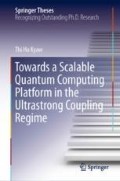Abstract
In this chapter, we propose to construct relatively large quantum error-correcting codes (QECCs) with the superconducting circuits architecture at the ultrastrong coupling regime. We are able to create highly entangled quantum state commonly known as cluster state by generating entanglement between any pair of qubits within a fraction of a nanosecond. We coin this process “pairwise cluster state generation”.
There is no success without failure and losses.
—John C. Maxwell
Access this chapter
Tax calculation will be finalised at checkout
Purchases are for personal use only
Notes
- 1.
We remind ourselves that this is simply the Josephson phase–voltage relation.
- 2.
We choose the linear magnetic sweep for simplicity. Other tuning scheme is equally valid as long as the adiabatic theorem is satisfied.
- 3.
As one sees that the number of qubits and the number two-qubit gates needed for both the five-qubit and the Steane codes are in the similar order, one expects to see the similar result for the Steane code, Fig. 4.8b, as compared to the five-qubit one as seen in Fig. 4.8a. The main reason of the difference is that we have assumed the projective measurement error \(p_m =0.01\) for the three orange colored qubits.
References
Nielsen MA, Chuang IL (2000) Quantum computation and quantum information. Cambridge University Press
Steane AM (1996) Error correcting codes in quantum theory. Phys Rev Lett 77:793
Raussendorf R, Briegel HJ (2001) A one-way quantum computer. Phys Rev Lett 86:5188
Ozeri R (2013) Heisenberg limited metrology using quantum error-correction codes. arXiv:1310.3432
Arrad G, Vinkler Y, Aharonov D, Retzker A (2014) Increasing sensing resolution with error correction. Phys Rev Lett 112:150801
Bourassa J, Gambetta JM, Abdumalikov A, Astafiev O, Nakamura Y, Blais A (2009) Ultrastrong coupling regime of cavity QED with phase-biased flux qubits. Phys Rev A 80:032109
Leib M, Deppe F, Marx A, Gross R, Hartmann MJ (2012) Networks of nonlinear superconducting transmission line resonators. New J Phys 14:075024
Leib M, Hartmann MJ (2014) Synchronized switching in a Josephson junction crystal. Phys Rev Lett 112:223603
Romero G, Ballester D, Wang YM, Scarani V, Solano E (2012) Ultrafast quantum gates in circuit QED. Phys Rev Lett 108:120501
Jaynes ET, Cummings FW (1963) Comparison of quantum and semiclassical radiation theories with application to the beam maser. Proc IEEE 51:89
Wang YD, Chesi S, Loss D, Bruder C (2010) One-step multiqubit Greenberger-Horne-Zeilinger state generation in a circuit QED system. Phys Rev B 81:104524
Herrera-Martí DA, Rudolph T (2013) Loss tolerance with a concatenated graph state. Quant Inf Comp 13:0995
Jeffrey E, Sank D, Mutus JY, White TC, Kelly J, Barends R, Chen Y, Chen Z, Chiaro B, Dunsworth A et al (2014) Fast accurate state measurement with superconducting qubits. Phys Rev Lett 112(19):190504
Niemczyk T, Deppe F, Huebl H, Menzel EP, Hocke F, Schwarz MJ, Garcia-Ripoll JJ, Zueco D, Hummer T, Solano E, Marx A, Gross R (2010) Circuit quantum electrodynamics in the ultrastrong-coupling regime. Nat Phys 6:772
Forn-Díaz P, Lisenfeld J, Marcos D, García-Ripoll JJ, Solano E, Harmans CJPM, Mooij JE (2010) Observation of the Bloch-Siegert shift in a qubit-oscillator system in the ultrastrong coupling regime. Phys Rev Lett 105:237001
Forn-Díaz P at Institute for Quantum Computing University of Waterloo (private communication)
Chow JM, Gambetta JM, Magesan E, Abraham DW, Cross AW, Johnson BR, Masluk NA, Ryan CA, Smolin JA, Srinivasan SJ et al (2014) Implementing a strand of a scalable fault-tolerant quantum computing fabric. Nat Comm 5:4015
Barends R, Kelly J, Megrant A, Veitia A, Sank D, Jeffrey E, White TC, Mutus J, Fowler AG, Campbell B et al (2014) Superconducting quantum circuits at the surface code threshold for fault tolerance. Nature 508(7497):500
Nickerson NH, Fitzsimons JF, Benjamin SC (2014) Freely scalable quantum technologies using cells of 5-to-50 qubits with very lossy and noisy photonic links. Phys Rev X 4:041041
Dennis E, Landahl A, Kitaev A, Preskill J (2002) Topological quantum memory. J Math Phys 43:4452
Raussendorf R, Harrington J, Goyal K (2006) A fault-tolerant one-way quantum computer. Ann Phys 321:2242
Raussendorf R, Harrington J (2007) Fault-tolerant quantum computation with high threshold in two dimensions. Phys Rev Lett 98:190504
Barrett SD, Stace TM (2010) Fault tolerant quantum computation with very high threshold for loss errors. Phys Rev Lett 105:200502
Wang DS, Fowler AG, Hollenberg LCL (2011) Surface code quantum computing with error rates over 1. Phys Rev A 83:020302(R)
Kyaw TH, Herrera-Martí DA, Solano E, Romero G, Kwek L-C (2015) Creation of quantum error correcting codes in the ultrastrong coupling regime. Phys Rev B 91:064503
Author information
Authors and Affiliations
Corresponding author
Rights and permissions
Copyright information
© 2019 Springer Nature Switzerland AG
About this chapter
Cite this chapter
Kyaw, T.H. (2019). Quantum Error-Correcting Codes in the USC Regime. In: Towards a Scalable Quantum Computing Platform in the Ultrastrong Coupling Regime. Springer Theses. Springer, Cham. https://doi.org/10.1007/978-3-030-19658-5_4
Download citation
DOI: https://doi.org/10.1007/978-3-030-19658-5_4
Published:
Publisher Name: Springer, Cham
Print ISBN: 978-3-030-19657-8
Online ISBN: 978-3-030-19658-5
eBook Packages: Physics and AstronomyPhysics and Astronomy (R0)

